Cygnus Entering The Atmosphere, Photographed By Alexander Gerst On The ISS.

Cygnus entering the atmosphere, photographed by Alexander Gerst on the ISS.
More Posts from Xnzda and Others

The Carina Nebula - A Birthplace Of Stars
The Carina Nebula lies at an estimated distance of 6,500 to 10,000 light years away from Earth in the constellation Carina. This nebula is one of the most well studied in astrophysics and has a high rate of star formation. The star-burst in the Carina region started around three million years ago when the nebula’s first generation of newborn stars condensed and ignited in the middle of a huge cloud of cold molecular hydrogen. Radiation from these stars carved out an expanding bubble of hot gas. The island-like clumps of dark clouds scattered across the nebula are nodules of dust and gas that are resisting being eaten away by photons (particles of light) that are ionizing the surrounding gas (giving it an electrical charge).
Credit: NASA/Hubble

At the Heart of Orion.

Cosmic Fireworks
Like an incredible celestial firework display, dust, ionized material and molecular gas from a dying star form the Helix Nebula. The star is evolving to become a white dwarf star and appears as the tiny blue dot seen at the center. This picture, taken in infrared light by the ESO’s VISTA telescope at the Paranal Observatory, reveals strands of cold nebular gas that is invisible in images taken in visible light. The main ring of the Helix is about two light-years across, roughly half the distance between the Sun and the nearest star. Material from the nebula spreads out from the star to at least four light-years. The Helix Nebula lies in the constellation of Aquarius about 700 light years from Earth. (Credit: ESO)

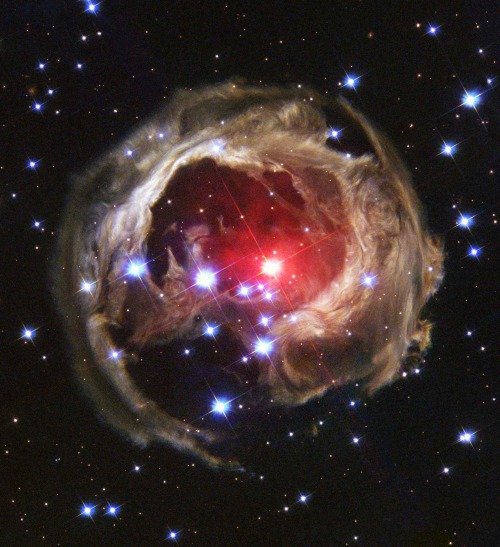
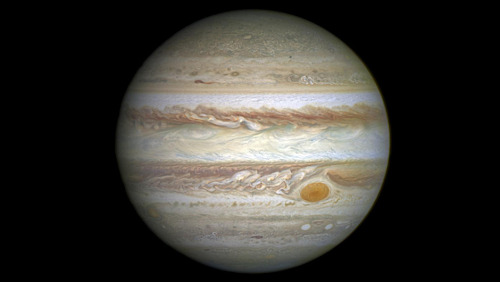
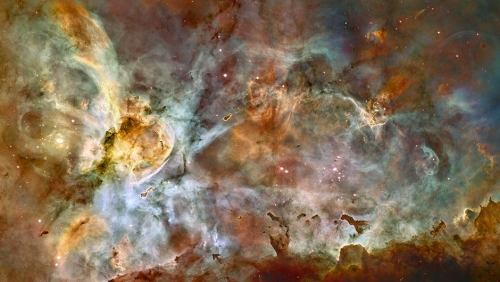
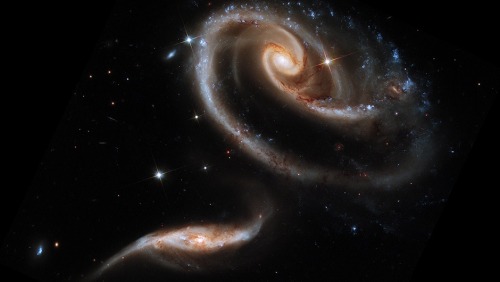

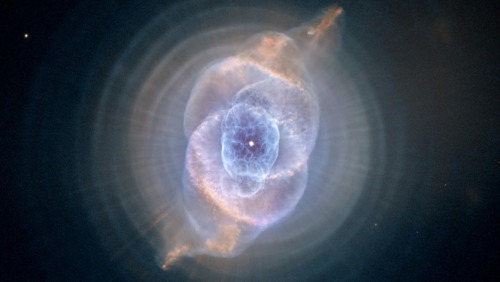
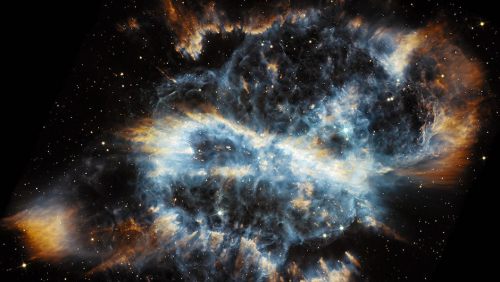
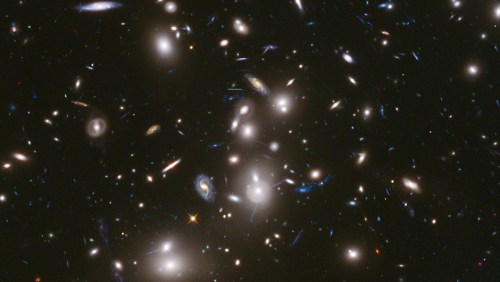
The best photographs that the Hubble space telescope has ever taken.
1. Sombrero galaxy
2. V838 Monocerotis
3. Jupiter’s great red spot
4. Carina nebula
5. Interacting galaxies
6. Pillars of creation
7. Cat’s eye nebula
8. Planetary Nebula NGC 5189
9. Abell 2744 Frontier Field
(Source)
Charting the Milky Way From the Inside Out
NASA - Wide-field Infrared Survey Explorer (WISE) patch. June 4, 2015
Image above: This artist’s concept depicts the most up-to-date information about the shape of our own Milky Way galaxy. We live around a star, our sun, located about two-thirds of the way out from the center. Image credit: NASA/JPL-Caltech/R. Hurt (SSC/Caltech). Imagine trying to create a map of your house while confined to only the living room. You might peek through the doors into other rooms or look for light spilling in through the windows. But, in the end, the walls and lack of visibility would largely prevent you from seeing the big picture. The job of mapping our own Milky Way galaxy from planet Earth, situated about two-thirds of the way out from the galaxy’s center, is similarly difficult. Clouds of dust permeate the Milky Way, blocking our view of the galaxy’s stars. Today, researchers have a suitable map of our galaxy’s spiral structure, but, like early explorers charting new territory, they continue to patiently and meticulously fill in the blanks. Recently, researchers have turned to a new mapping method that takes advantage of data from NASA’s Wide-field Infrared Survey Explorer, or WISE. Using WISE, the research team has discovered more than 400 dust-shrouded nurseries of stars, which trace the shape of our galaxy’s spiral arms. Seven of these “embedded star clusters” are described in a new study published online May 20 in the Monthly Notices of the Royal Astronomical Society.
Image above: (Annotated) This artist’s concept depicts the most up-to-date information about the shape of our own Milky Way galaxy. We live around a star, our sun, located about two-thirds of the way out from the center. Image credit: NASA/JPL-Caltech/R. Hurt (SSC/Caltech). “The sun’s location within the dust-obscured galactic disk is a complicating factor to observe the galactic structure,” said Denilso Camargo, lead author of the paper from the Federal University of Rio Grande do Sul in Brazil. The results support the four-arm model of our galaxy’s spiral structure. For the last few years, various methods of charting the Milky Way have largely led to a picture of four spiral arms. The arms are where most stars in the galaxy are born. They are stuffed with gas and dust, the ingredients of stars. Two of the arms, called Perseus and Scutum-Centaurus, seem to be more prominent and jam-packed with stars, while the Sagittarius and Outer arms have as much gas as the other two arms but not as many stars. The new WISE study finds embedded star clusters in the Perseus, Sagittarius, and Outer arms. Data from the Two Micron All Sky Survey (2MASS), a ground-based predecessor of WISE from NASA, the National Science Foundation and the University of Massachusetts, Amherst, helped narrow down the distances to the clusters and pinpoint their location. Embedded star clusters are a powerful tool for visualizing the whereabouts of spiral arms because the clusters are young, and their stars haven’t yet drifted away and out of the arms. Stars begin their lives in the dense, gas-rich neighborhoods of spiral arms, but they migrate away over time. These embedded star clusters complement other techniques for mapping our galaxy, such as those used by radio telescopes, which detect the dense gas clouds in spiral arms.
Image above: Astronomers using data from NASA’s Wide-field Infrared Survey Explorer, or WISE, are helping to trace the shape of our Milky Way galaxy’s spiral arms. Image credit: NASA/JPL-Caltech/Federal University of Rio Grande do Sul. “Spiral arms are like traffic jams in that the gas and stars crowd together and move more slowly in the arms. As material passes through the dense spiral arms, it is compressed and this triggers more star formation,” said Camargo. WISE is ideal for finding the embedded star clusters because its infrared vision can cut through the dust that fills the galaxy and shrouds the clusters. What’s more, WISE scanned the whole sky, so it was able to perform a thorough survey of the shape of our Milky Way. NASA’s Spitzer Space Telescope also uses infrared images to map the Milky Way’s territory. Spitzer looks along specific lines of sight and counts stars. The spiral arms will have the densest star populations.
NASA’s Wide-field Infrared Survey Explorer, or WISE. Image Credit: NASA
NASA’s Jet Propulsion Laboratory in Pasadena, California managed and operated WISE for NASA’s Science Mission Directorate in Washington. The spacecraft was put into hibernation mode in 2011, after it scanned the entire sky twice, thereby completing its main objectives. In September 2013, WISE was reactivated, renamed NEOWISE and assigned a new mission to assist NASA’s efforts to identify potentially hazardous near-Earth objects. Other authors of the study are: Charles Bonatto and Eduardo Bica, also with the Federal University of Rio Grande do Sul. For more information on WISE, visit: http://www.nasa.gov/wise Previous research from Camargo’s team found two embedded clusters far outside the plane of our Milky Way, 16,000 light-years away. A feature story about that work is online at: http://www.jpl.nasa.gov/news/news.php?feature=4497 The new WISE study from the Monthly Notices of the Royal Astronomical Society is online at: http://mnras.oxfordjournals.org/content/450/4/4150.full?keytype=ref&ijkey=tjeJAezGAmgdXzc Images (mentioned), Text, Credits: NASA/Felicia Chou/JPL/Whitney Clavin/Tony Greicius. Best regards, Orbiter.ch Full article
Charting the slow death of the Universe
Paris (SPX) Aug 12, 2015 The study, which is part of the Galaxy And Mass Assembly (GAMA) project, the largest multi-wavelength survey ever put together, involved many of the world’s most powerful telescopes [1]. “We used as many space and ground-based telescopes as we could get our hands on to measure the energy output of over 200 000 galaxies across as broad a wavelength range as possible,” says Simon Driver ICRA Full article


Spirit sends one of those pictures that looks like it could come from the red rock deserts of the American West, but actually shows part of the landscape in Gusev crater, a mere 60 million miles away. Credit: NASA
The dune field at the center of Victoria Crater, seen in a new false-color shot. Credit: NASA
-
 xnzda reblogged this · 5 years ago
xnzda reblogged this · 5 years ago -
 unreposed reblogged this · 6 years ago
unreposed reblogged this · 6 years ago -
 somberparty liked this · 6 years ago
somberparty liked this · 6 years ago -
 snoozy-red-panda reblogged this · 6 years ago
snoozy-red-panda reblogged this · 6 years ago -
 cherilunee liked this · 6 years ago
cherilunee liked this · 6 years ago -
 reduced-sour-cream liked this · 6 years ago
reduced-sour-cream liked this · 6 years ago -
 snoozy-red-panda liked this · 6 years ago
snoozy-red-panda liked this · 6 years ago -
 fairycosmos reblogged this · 6 years ago
fairycosmos reblogged this · 6 years ago -
 lunamemes liked this · 6 years ago
lunamemes liked this · 6 years ago -
 4thavenuecafe reblogged this · 6 years ago
4thavenuecafe reblogged this · 6 years ago -
 neptunevi reblogged this · 6 years ago
neptunevi reblogged this · 6 years ago -
 bagdasan liked this · 6 years ago
bagdasan liked this · 6 years ago -
 saltedyolk liked this · 6 years ago
saltedyolk liked this · 6 years ago -
 kihi reblogged this · 6 years ago
kihi reblogged this · 6 years ago -
 driftingisland liked this · 6 years ago
driftingisland liked this · 6 years ago -
 zombimanos liked this · 6 years ago
zombimanos liked this · 6 years ago -
 veteran-of-a-coldwar reblogged this · 6 years ago
veteran-of-a-coldwar reblogged this · 6 years ago -
 kida23 reblogged this · 6 years ago
kida23 reblogged this · 6 years ago -
 eleventhdoctorandamy reblogged this · 8 years ago
eleventhdoctorandamy reblogged this · 8 years ago -
 luzex reblogged this · 8 years ago
luzex reblogged this · 8 years ago -
 nolifedestiny liked this · 8 years ago
nolifedestiny liked this · 8 years ago -
 psycho-pep reblogged this · 8 years ago
psycho-pep reblogged this · 8 years ago -
 ruthvermouth-blog liked this · 8 years ago
ruthvermouth-blog liked this · 8 years ago -
 alcantar24 liked this · 8 years ago
alcantar24 liked this · 8 years ago -
 casey-the-strange liked this · 8 years ago
casey-the-strange liked this · 8 years ago -
 maamjenoetta reblogged this · 8 years ago
maamjenoetta reblogged this · 8 years ago -
 bigtiddydevilbf reblogged this · 8 years ago
bigtiddydevilbf reblogged this · 8 years ago -
 fairyof-fruitjuice reblogged this · 8 years ago
fairyof-fruitjuice reblogged this · 8 years ago -
 fairyof-fruitjuice liked this · 8 years ago
fairyof-fruitjuice liked this · 8 years ago -
 wanatar liked this · 8 years ago
wanatar liked this · 8 years ago -
 mini-space-alien-blog reblogged this · 8 years ago
mini-space-alien-blog reblogged this · 8 years ago -
 flamexec liked this · 9 years ago
flamexec liked this · 9 years ago -
 xxv-xi-mcmxcvii liked this · 9 years ago
xxv-xi-mcmxcvii liked this · 9 years ago

![M51, The Whirlpool Galaxy [3450 X 3697]](https://64.media.tumblr.com/e3d38132c6a1bab2d6a3d758e2137b6d/tumblr_plzsxlWKMO1ve10t6o1_500.jpg)
